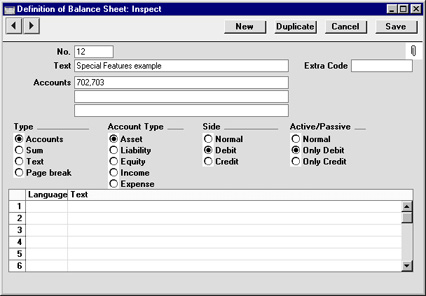Balance Sheet - Special Features
This section has no relevance for those companies that practise standard western accounting conventions.

In the Balance Sheet definition, there are two groups of options which need a special mention. This design has been made in order to facilitate certain accounting and reporting requirements in various countries. The easiest way to explain the usefulness of these facilities is with the help of an example. In most companies, there are a number of reconciliation or suspense accounts, either assets or liabilities, which alternately can hold debit or credit balances. The accounting conventions of some countries only allow "pure" debit or credit accounts, and when a balance sheet is produced, it becomes necessary to move individual accounts back and forth between the active or the passive groups, depending on the current positive or negative balance.
To complicate things even further, in some countries it is customary to distinguish between four different "states" of a book entry: Debit+, Debit-, Credit+ and Credit-. In modern western accounting systems, a book entry is either debit or credit, regardless of the class of the account, i.e. we have a simple arithmetic definition of balances.
In those environments where all these special rules are used, the preparation of balance reports tends to become complicated and labour consuming. These special functions of Hansa allow the far-reaching automation of many of these routine tasks. This is how it works.
Let us start with the following Nominal Ledger report, showing the actual debit and credit balances for two Accounts.
Account 702 - Bank Current Account 2:

Account 703 - Bank Current Account 3:

Account no. 703 is defined as an asset, and currently has a balance in credit. Total Debits during the period is 15, and total Credits 1000. Account no. 702 has a normal debit balance, but on this account two negative values have been entered, one in debit and one in credit. If the Accounts are used in a report definition in the normal way, with the buttons Side:Normal and Active/Passive:Normal selected, the balance of Account no 703 will be shown as a negative asset value.

With the buttons Side:Debit and Active/Passive:Only Debit options selected, the debit column total for Account 702 will be shown, because the Account balance is in debit:

With Side:Credit and Active/Passive:Only Credit selected, the balances from both the Accounts' credit columns will be shown, because both are negative.

With Side:Credit and Active/Passive:Only Debit selected, nothing will be shown, because the credit column of Account 702 has a positive value, and 703 has a overall debit balance.
With Side:Debit and Active/Passive:Only Credit selected, once again nothing will be shown.
The combination Side:Credit and Active/Passive:Normal shows the credit column balances for both Accounts:

